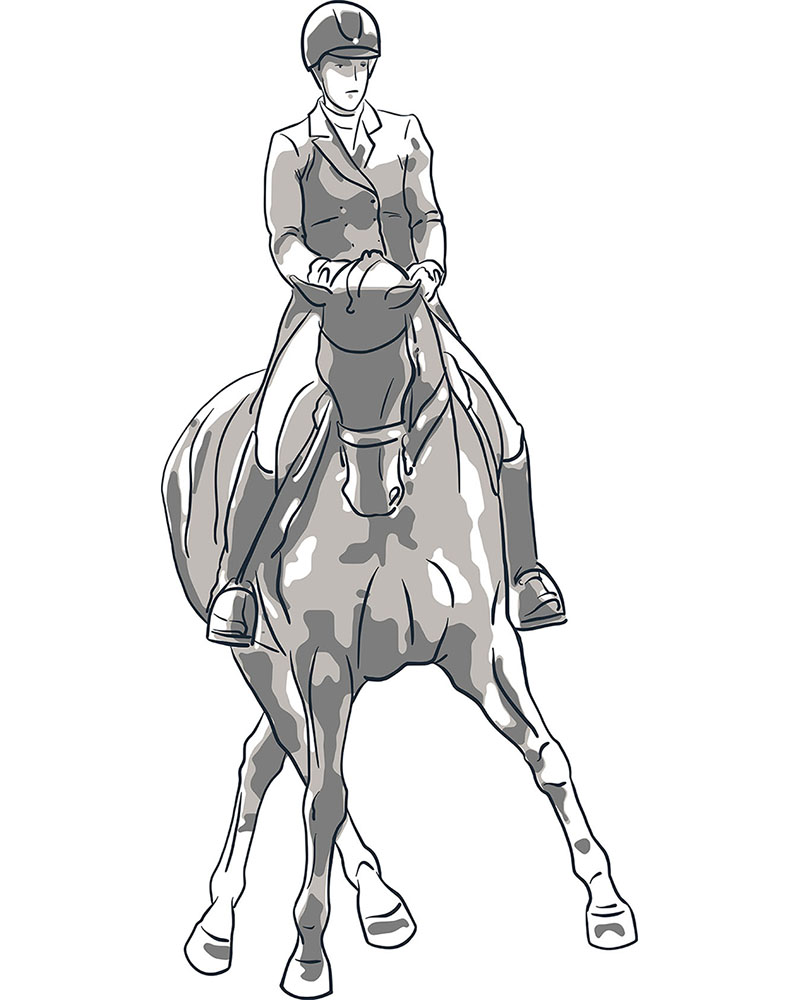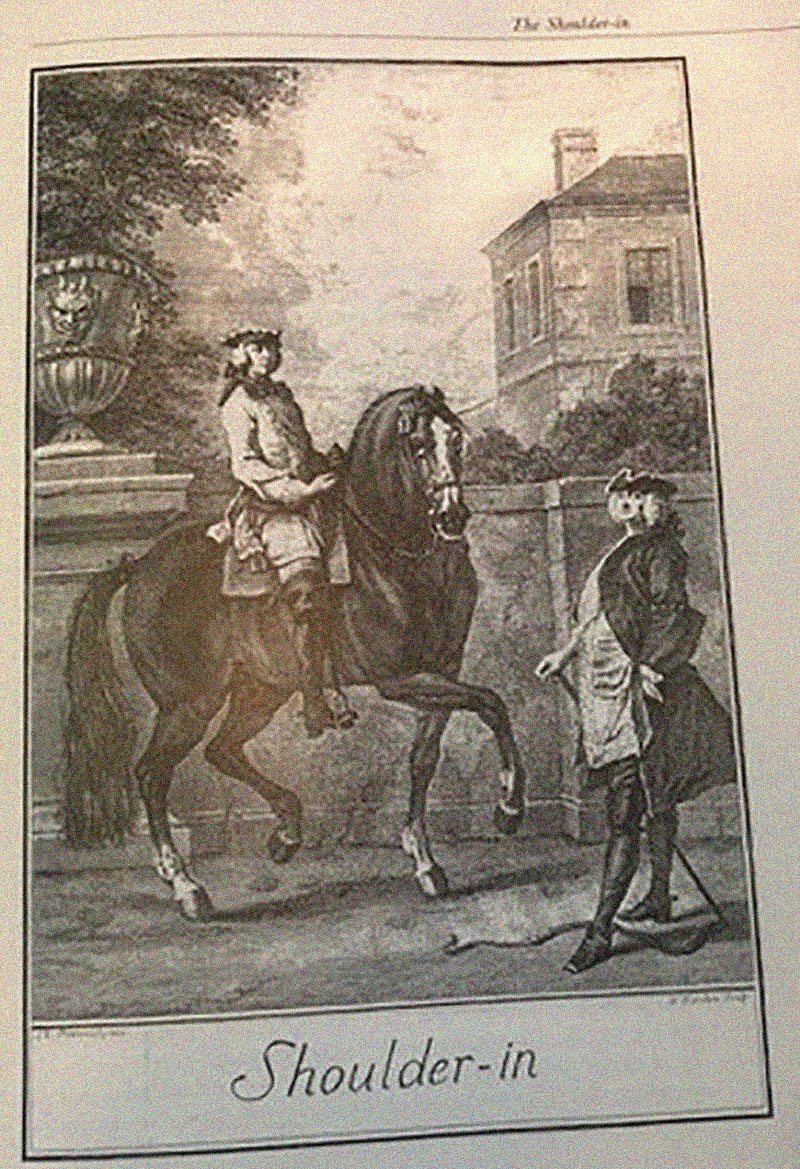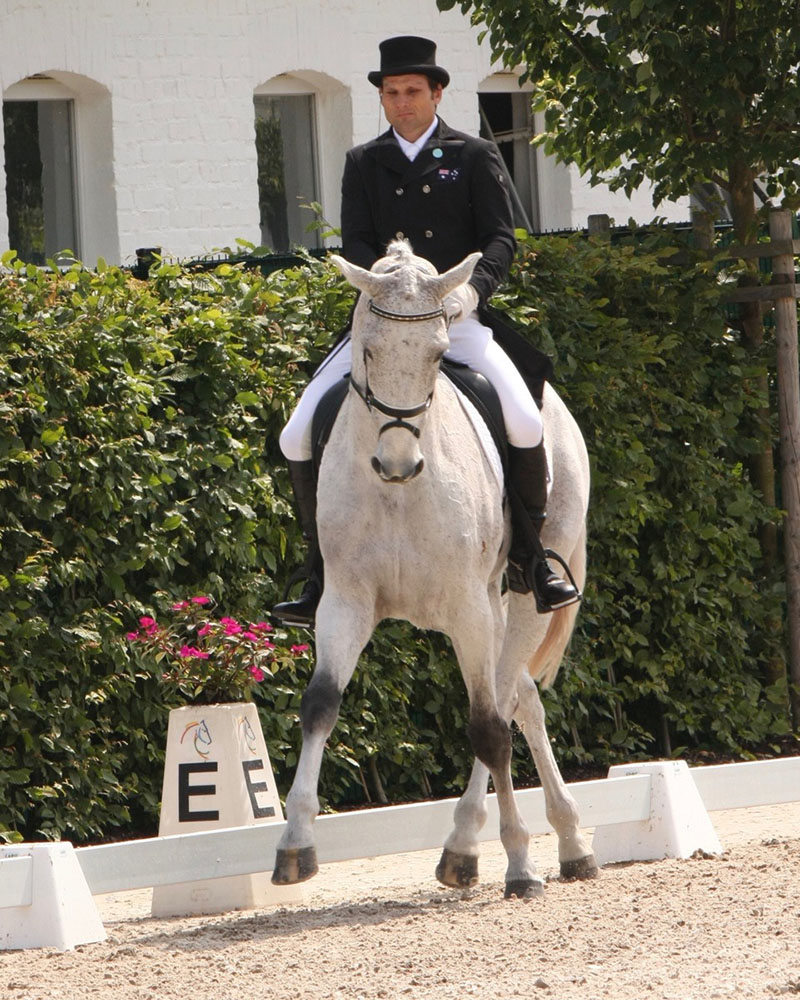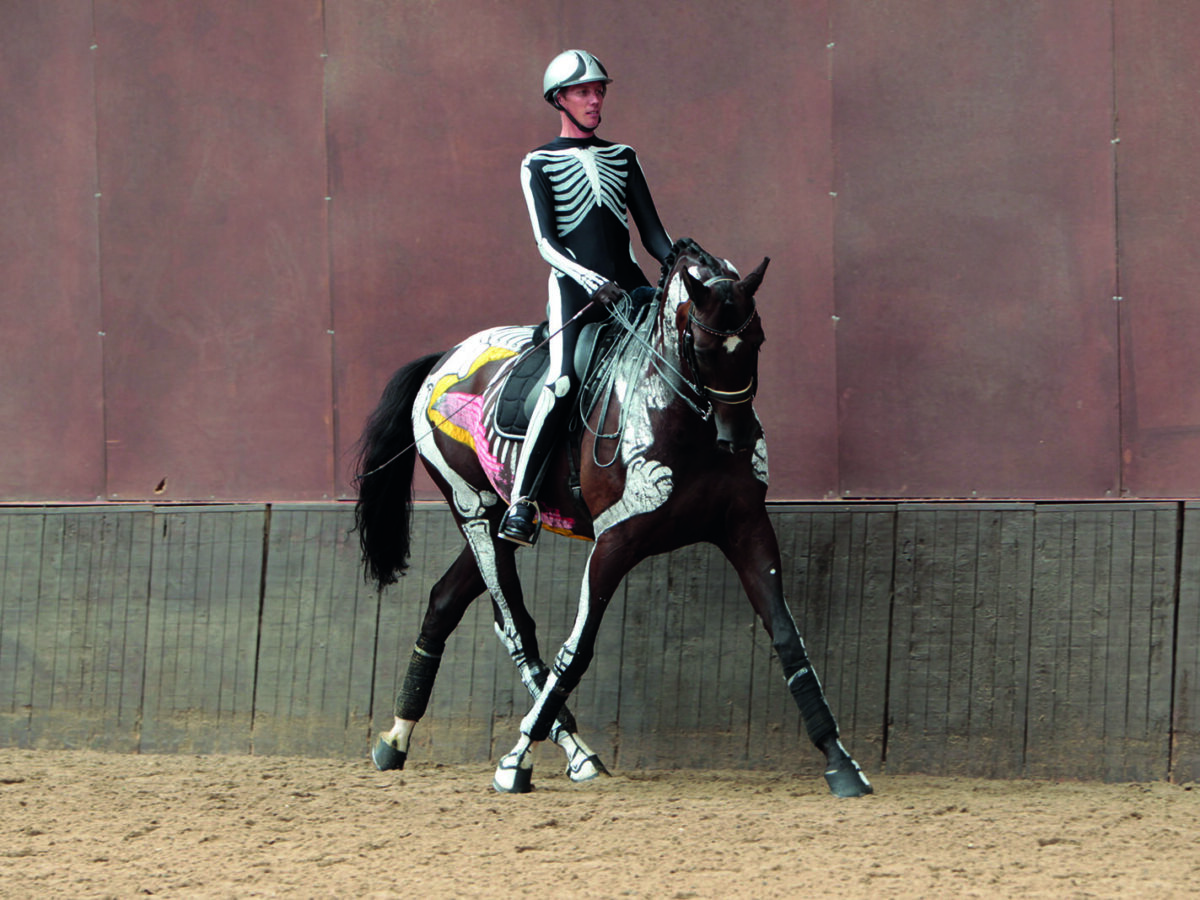“The shoulder-in is the first and last lesson one must give a horse,” said de la Gueniniere, the classical master who invented it, in 1733. “I regard it as the alpha and omega of all exercises for the horse which are designed to develop complete suppleness and agility.”

De la Gueniniere lists the benefits of the shoulder-in as including suppling the shoulders, preparing the horse for collection by teaching him to bend his hocks under himself, teaching him to move away from the rider’s leg, and cross both fore and hindlegs.
We now know that there is another very important benefit. The shoulder-in relaxes the horse. In May 2020, a study was published in the Journal of Veterinary Behaviour (see citation at end of article) that demonstrated scientifically that the shoulder-in helps horses to relax and to pay attention in their training.
It is only recently that science has been applied to equestrian pursuits. Equestrians are naturally conservative and do things because that’s the way they have always done it. Science helps us evaluate what we do. I think that this is a really important finding that can help all of us train more intelligently. We want our horses to be more relaxed and therefore happier in their work. Relaxed work is more beautiful. Relaxed horses learn faster, and are softer and easier to ride.
So, if we know that the shoulder-in, (and possibly other lateral work, where we bend and therefore soften the horse) helps relax the horse, then we can use the shoulder-in and other lateral work in the warm-up to start with relaxation before we teach new or harder things. We can return to the shoulder-in and other lateral work if a horse becomes tense because the work is harder, or even if the environment is stressful. Any time the horse becomes tense we could use the shoulder-in and lateral work to relax.
For example, if you are teaching the flying change and he becomes confused and tense, just change the subject to shoulder-in, get him relaxed and around your inside leg before you ask again. You are at a show and he isn’t coping well with the noise around him, so warm up with lots of lateral work to make him relaxed in his body and in his mind. You have been doing a jumping exercise and he starts to run and get tense, just go back to shoulder-in and get him soft and paying attention and then go back to the jumping exercise. Teach him that being relaxed is the starting point. Remember that the horse is a flight animal, and so learns best when relaxed. A tense horse just wants to run away.
So, what is the evidence that the shoulder-in relaxes the horse? Well the researchers in France took 40 competition horses in work and who had been trained in the shoulder-in, and tested them twice — once with an amateur and once with a professional. A great deal of data was collected. Biomechanical data included frequency and regularity of strides. Physiological data included heart rate variability (HRV), which is well recognised as a physiological indicator of relaxation in humans and animals (Read more). Behavioural data included playing with, and chewing the bit (PCB) and looking around, as a measure of the horse’s concentration. Playing and chewing the bit is considered a normal and desirable behaviour associated with relaxation. Data was analysed for statistical significance.
Each testing session comprised of a normal warm-up of 5-10 minutes riding normally around the arena. Then horses were ridden for 10 minutes in a straight frame, 5 minutes on each rein, and a standard time at each gait. Then they were rested before doing a standard 10-minute workout of lateral working the three paces, 5 minutes on each rein and standard time at each gait.

“I think that
this is a really
important finding.”
The most significant findings included that horses looked around less frequently when doing the shoulder-in work, indicating that they were paying better attention to the rider, regardless of the rider’s experience. Horses chewed and played with the bit more in the shoulder-in work. This indicated that the horses were more relaxed. Furthermore, the heart rate monitoring indicated that horses were more relaxed in the lateral work than the straight work. This effect was more pronounced when horses were ridden by professional riders.
Training the lateral work usually will start with the initial groundwork. Horses easily learn to yield the hindquarters in response to pressure near the ribs or flank. Always ask them to yield the hindquarters by stepping forward and under the body with the inside hind leg, so even in the groundwork they are learning to bend the hocks and carry weight in a balanced way. This continues under saddle.
The leg yield is easy to introduce by riding a small circle, so small that it is a little difficult for him, then ask for a bigger circle with your inside leg to outside rein. When the leg yield is easy for him in trot, you can introduce the shoulder-in. Trot is preferred to teach the shoulder-in as the rhythm is a simple two beats and there is enough impulsion to allow the exercise to do its job of suppling. Ride a small circle to establish the bending and when you come to the wall continue in the circle one more step so that the shoulders are on an inside line, the horse bent around your inside leg and the hindquarters are on the outside track of the arena.
In this position, lead the horse along the long side with your outside rein. Your inside hip will follow a line forward between the horse’s shoulder. Your outside leg will guard that the hindquarters don’t fall out, losing the bend and therefore losing the benefit of the exercise. As usual, your shoulders are parallel to his shoulders, facing towards the middle of the arena, and your hips will be parallel to his hips, square to the long side. You will be able to soften your inside rein to make space for the inside hind leg to come into.

The inside rein does not make the bend. You do not pull the inside rein to steer him into the shape you want; rather it is your inside leg that bends him. You do not want to shorten the inside of the horse, but lengthen the outside line. Muscles work better when they are stretched. You want him to stretch into the bending.
Originally de la Gueniniere recommended that the angle to the wall be sufficient that the horse’s legs are on four tracks. This is recommended by Podjahsky and it is practiced this way at the Spanish Riding School. The current rules of dressage recommend a lesser angle and three tracks, the inside hind leg and the outside front leg being on the same track. A 30-degree angle to the track is recommended.
Another way to explain the shoulder-in to the horse is to start with a leg yield from the centreline to the wall, developing the bend around the inside leg and then placing the horse so that the hindquarters meet the wall first, and then lead the shoulders along the line of the long side with the outside rein and continue in the shoulder-in.
Of course, if you are doing it in sitting trot you will find it easier to apply the aids in the correct rhythm to best influence the inside hind leg to step up if you remain aware of the correct diagonal. I have discussed this elsewhere.


As the horse develops the balance and suppleness, the quality of the trot becomes the focus. Keep the rhythm and energy that you had in the straight line for a simple circle. You can do little transitions within the shoulder-in. Trot, walk, trot transitions, paying attention to the constancy of the balance and keeping the wither up, will further develop the ability of the horse to collect. Remember the Training Scale: Rhythm, suppleness, contact, straightness, impulsion, collection. These are the qualities that you want to ride into your shoulder-in.
The shoulder-in can be ridden in all three paces. We can use shoulder-in in the passage as well to develop strength and suppleness. You can ride it along the wall, in circles, taking care that the hindquarters don’t swing out. You can ride it in serpentines on either the curves or the straight lines. You can ride out the shoulder-in on a diagonal line in medium trot, making use of the engagement of the hindquarter to push into the medium trot. The higher level tests place the shoulder-in on the centreline, a real test of control. You can ride half-pass, shoulder-in, half-pass to also assist the horse to build balance, strength and reach in the half-pass.
Once you have mastered the shoulder-in, the other lateral exercises of travers, renvers and half-passes will follow on.
So next time that your horse becomes tense, why not play with the lateral work and experiment yourself how he responds? You could do it from the ground, or do it from the saddle, but find out for yourself how what we are coming to know from science can inform your practice.
Have fun.
Kerry.

